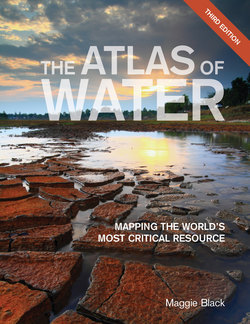Читать книгу The Atlas of Water - Maggie Black - Страница 9
На сайте Литреса книга снята с продажи.
Оглавлениеquality of water descending downstream. Non-renewable supplies, in the form of fossil-water aquifers formed millennia ago, are becoming rapidly exhausted. Every drop of available supply has to be harnessed to agricultural, industrial or domestic use – and sometimes all three in sequence. The volume of renewable supplies remains constant and is unlikely to falter, despite the many meteorological fluctuations associated with global warming. But the pressures exerted on this finite supply, both from increased population, and from the increasing number of people expecting to enjoy an industrialized lifestyle, are profound. Competition between different types of use, and between upstream and downstream users, is becoming more acute. The extraordinary nature of the substance compounds the many difficulties of managing water in such a way that all these conflicting interests are adjudicated fairly. Awareness of the critical limits on freshwater supplies has been growing over the past 20 years, alongside more profound appreciation of environmental constraints. Indeed, the circulation of water in the environment – to preserve wetlands, conserve biodiversity, and protect climate stability – has itself become recognized as a category of “water use” necessary to nurture the planet and its other life-giving resources. One strategy for water conservation has been to attach an economic value to all its uses and apply market instruments, such as water-pricing, to prevent profligate extraction and consumption. But the treatment of water as a commodity like any other, to be traded and used for corporate profit-making, has caused huge resentment. In those societies where poverty is acute, and rural farmers and urban dwellers are surviving at levels close to subsistence, unsubsidized water services effectively mean no water services at all. However important it is to conserve supplies, the story of water will be even more unjust if the least well-off bear a disproportionate burden of the costs. In fact, the problem of water as it relates to people in non-industrial environments is that most of them use too little water, rather than too much. Around 700 million people are still without a reliable source of drinking water, and 2.4 billion people are without basic sanitation. Having no tap at home constrains water use to the point where lack of personal hygiene is at least as much of a disease risk as lack of safe drinking water. Any attempt to improve water management in such a way as to make distribution more just should spread services to those with no protected water supply, many of whom currently spend much more on water purchased by the litre and carried home in a pot, than those living where pipes and taps are prolific. With water, as with pressure on other natural resources, it is not the poor who are pumping up industrial-scale quantities to sell as a marketized commodity, or to irrigate sugar or cotton plantations in unsuitable dryland environments. Nor are they manufacturing or buying televisions, computers, cars or other sophisticated consumer products. It is not the disadvantaged and underfed who are polluting rivers with pesticide residues and chemical wastes, or eating farmed fish or hamburgers requiring large quantities of water for their production. The industrial lifestyle is propped up by water even more than it is propped up by oil.
10
